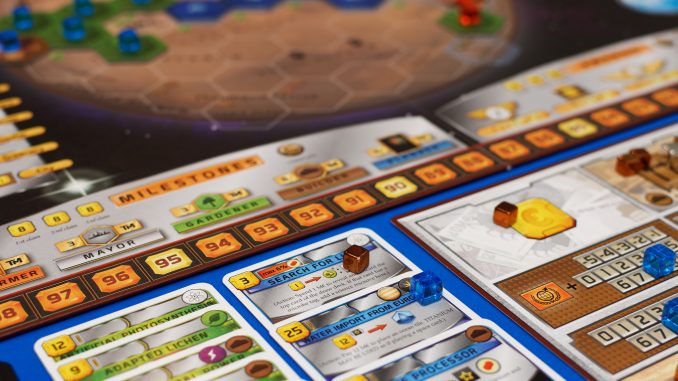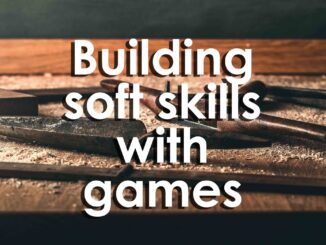
The process of designing learning games should always start with the learning. Games, although they are at the heart of all we do, are just a tool for implementing the outcomes we have already designed. So outcomes come first, and only then should one start to consider the experience that should be created for the learners.
But for me, and from conversations I’ve had with other designers, for many others, the fun bit of this process is when you can start to map the learning outcomes and activities to real game mechanics. This is when the game starts to come to life and you can relive previous experiences of play to pinpoint the most appropriate gameplay for each of the experiences you want to create.
While it is not an exact science, over the years, I have created mappings of different game mechanics and modes to different topics and learning outcomes. Some are very obvious. For example, if you are tasked with creating learning around team cohesion, it would make sense to use co-operative gameplay rather than competitive, unless you are trying to demonstrate how NOT to do it. If you need an experience where players will be subject to external events, use an events track or some kind of random event generator.
When considering Sustainability learning, these are a couple of staple ideas which I find myself returning to time and again, and some subsidiary mechanics which I find are useful to add interest, motivation to learn and an element of uncertainty. In next month’s magazine, I will look at some of those in more detail.
Resource Management

Resource Management is a very common mechanism in commercial games, which gives us, as learning designers, lots of raw material to work with when seeking inspiration. Many of the issues we face in Sustainability relate to the use (and misuse, and abuse) of planetary resources. While it is not a given in every case, Resource Management can be a very good start as a main mechanic in your game design.
What follows is a list of games which use resource management (some commercially available, and some created by learning providers for their clients) in a variety of ways and suggestions as to what each offers for sustainability learning.
- Best for demonstrating complex interconnectedness – Castle Dice. A fun family game, with a really impressive and elegant resource management / worker placement mechanic at its heart. The Castle Dice ‘engine’ is powered by five different resources, which can be spent to build parts of a castle and ‘villagers’ who carry out work in four different ways – to produce more resource, to guard resource, to trade in resources and farming animals. Collection of animals of different types enables different powers within the game. It sounds complex, and it is. Each working part is linked to every other part, and that is a powerful lesson when creating environmental learning – reflecting the elegance of properly functioning natural systems. The game itself would not be suitable to teach sustainability but using this ‘resource engine’ as a model for your designs would give you a compelling learning experience.
- Managing resources to perform ‘projects’ – Terraforming Mars. In this game, global warming is a positive outcome, not a problem, but it is the management of resources to implement projects that is interesting here. Project cards are used by many sustainability learning games, such as The SDG 2030 game – mentioned in another article this month. This kind of project mechanic – implemented by ‘buying’ and playing projects is especially useful for corporate learning as this can be adapted to reflect the way that learners actually work in their jobs. Imagine creating a game to simulate the implementation of sustainability projects within their business. The science behind the projects is also sound and well represented within the game. A really interesting aspect is that some projects can only be played once certain planetary conditions are met – a mechanism that I found very useful when recently creating a ‘planetary boundaries/tipping points’ learning game.

- Games requiring ‘balance’ of resource creation/deployment. This has been a feature of several learning games I have created – probably an artefact of working in corporate learning during the era of the ‘triple bottom line’. Designing games such as this require a delicate balancing act of design too. There are non-trivial problems which have to be solved, not least of which is contriving a measure for social and environmental value. Of necessity the measure of the three values have different units, which either require ‘equalising’ to the same level of granularity, or complex weighting. Fligby is an interesting game with a triple bottom line theme, which is the subject of an article in next month’s magazine.
- Showing effect of ‘hoarding’ finite resources – Snowdonia. Not so much a designed mechanic, but an interesting by-product of a re-stocking of centrally held resources. In Snowdonia players compete to complete the most work in building a railway from Llanberis to the summit of Mt. Snowdon in Wales. Resources such as iron ore, coal, stone and excavated rubble are variously gained, converted into secondary products and utilised to build the railway. If players hold these in personal stock instead of converting or using them (both of which cause them to go back into available central store), these resources can run out, effectively preventing some players from playing at all. A mechanic which could be useful if illustrating the ‘Tragedy of the Commons’ for example.
Tips for designing resource management / game economies and markets etc.
This example uses potential representations of social, economic and environmental value. Obviously, representation and manipulation of numeric values relates to any resources, inputs and outputs. These are used here as an example.

The creation of different measures of value can be problematic, as above. It is always best practice to keep in-game measures of value as simple as possible. One way to do this is to measure everything by conversion to a single unit. For example, measuring social and environmental value in terms of money (Natural Capital is a real-world example of this). But while this will make your game mechanics simpler to implement and for learners to understand, you need to be sure that this is a learning you want people to take from the game. Some people are opposed to the idea of Natural Capital, believing it devalues the natural world, by expressing its worth purely in human terms.
An alternative approach would be to create separate measures for each aspect (e.g. economic, social and environmental value), but to create a separate value to represent the aggregation of these (victory points or similar).
A different but related issue is one of granularity, which again becomes very obvious when trying to make different values comparable. This is especially important if you are creating a tabletop game, using physical pieces to represent resources and measures of value, as players must be able to actually physically hold and play with the quantity of things you have decided on. A good analogy for this would be to imagine you are trying to create a scale for a graph which could be sensibly viewed. If you measure your social value as a percentage (0-100), and do the same for your environmental value, you could show both of those on a graph with a scale of 0-100 (and sensibly view how they relate to each other). But if you then added economic value – let’s say that within the game this might have a range of between -20 million (debt) and 500 million. You clearly can’t use a 1:1 scale for the money. The -20 million to 500 million scale would render the social and environmental value microscopic. Even if you showed money in units of 1 million, you would be looking at an unwieldy scale, and you would be stuck with having 1 million as your smallest transaction value!
Abstraction is by far the best approach. You can already do that with social and environmental value, because they are abstraction. We don’t have real-world units for these. Simply do the same for money. Forget realistic representation, and create an abstract economic unit. You could, if you must, also keep your granular units for transactions but convert results back to the abstraction for results – but why bother. That’s just an extra layer of complexity you don’t need.
Use a spreadsheet to model your game economy and effects of decisions on your metrics. It provide an easy way to check all the possible routes through the play. But move to an analogue prototype (even if your final game is destined to be computer based) to check how understandable your inputs and outputs are, and to check that counting does not get in the way of learning. A good rule of thumb would be that no numeric representation in your game should be greater than 20 – a figure which you could easily count and understand in a few seconds. So let’s return to our previous percentages and make them a score out of 20 instead.
Even if your game calculations are so complex (e.g. the modelling of the effects of different decisions made in the game) that they can only be done by a computer, your outputs need to be simple enough to be quickly understood otherwise the simplicity of the learning message is compromised.
‘Resource Management’ is a term used to describe a wide variety of games, with differing mechanics and an almost infinite range of gameplay possibilities. It is well worth exploring what this mechanic has to offer.
- James Bore – The Ransomeware Game - 13th February 2024
- Ipsodeckso – Risky Business - 23rd January 2024
- Review – Luma World Games - 15th December 2023





Be the first to comment